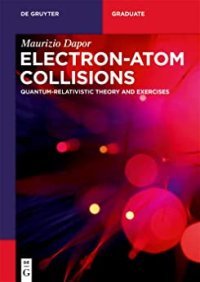
Ebook: Electron–Atom Collisions
Author: Maurizio Dapor
- Genre: Physics // Quantum Physics
- Year: 2022
- Publisher: Walter de Gruyter
- City: Berlin/Boston
- Language: English
- pdf
This book deals with collisions of electrons with atoms. Both the nonrelativistic and
the relativistic theories are presented here. Since we are interested in applications,
the first part of the book is devoted to the basic concepts of computational physics,
describing the main numerical tools necessary for solving problems concerning the
scattering of charged particles by central fields. We also briefly describe the main special
functions of mathematical physics and provide methods to numerically calculate
them. The second part of the book is dedicated to the nonrelativistic approach to the
study of electron–atom scattering and to an introduction to Pauli matrices and spin.
The Thomas Fermi and Hartree–Fock methods for describing many-electron atoms
and, in particular, for calculating the so-called screening function are described in
the second part of the book. The screening function is crucial for the calculation of
phase shifts, and its analytical approximation is also presented to make easier the calculation
of the electrostatic atomic potential. In the third part of the volume, after an
introduction to the quantum relativistic equations (Klein–Gordon equation and Dirac
equation), the Mott theory is described. It represents the quantum-relativistic theory
of elastic scattering of electrons by central fields, the so-called relativistic partial wave
expansion method. The last part of the book presents several applications. It contains
exercises devoted to the calculation of the special functions of mathematical physics
(notably, Legendre polynomials and spherical Bessel functions, both regular and irregular)
and to their use for computing phase shifts, scattering amplitudes, differential
elastic scattering cross-sections, and spin-polarization parameters. The exercises
are provided with an increasing degree of difficulty. With the aid of these exercises,
the reader can use all the information described in the first three parts of the book to
write her/his own computer codes for the computation of all the quantities relevant to
the scattering processes.
the relativistic theories are presented here. Since we are interested in applications,
the first part of the book is devoted to the basic concepts of computational physics,
describing the main numerical tools necessary for solving problems concerning the
scattering of charged particles by central fields. We also briefly describe the main special
functions of mathematical physics and provide methods to numerically calculate
them. The second part of the book is dedicated to the nonrelativistic approach to the
study of electron–atom scattering and to an introduction to Pauli matrices and spin.
The Thomas Fermi and Hartree–Fock methods for describing many-electron atoms
and, in particular, for calculating the so-called screening function are described in
the second part of the book. The screening function is crucial for the calculation of
phase shifts, and its analytical approximation is also presented to make easier the calculation
of the electrostatic atomic potential. In the third part of the volume, after an
introduction to the quantum relativistic equations (Klein–Gordon equation and Dirac
equation), the Mott theory is described. It represents the quantum-relativistic theory
of elastic scattering of electrons by central fields, the so-called relativistic partial wave
expansion method. The last part of the book presents several applications. It contains
exercises devoted to the calculation of the special functions of mathematical physics
(notably, Legendre polynomials and spherical Bessel functions, both regular and irregular)
and to their use for computing phase shifts, scattering amplitudes, differential
elastic scattering cross-sections, and spin-polarization parameters. The exercises
are provided with an increasing degree of difficulty. With the aid of these exercises,
the reader can use all the information described in the first three parts of the book to
write her/his own computer codes for the computation of all the quantities relevant to
the scattering processes.
Download the book Electron–Atom Collisions for free or read online
Continue reading on any device:

Last viewed books
Related books
{related-news}
Comments (0)